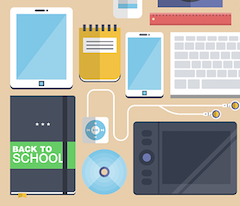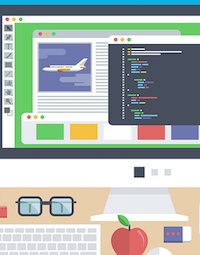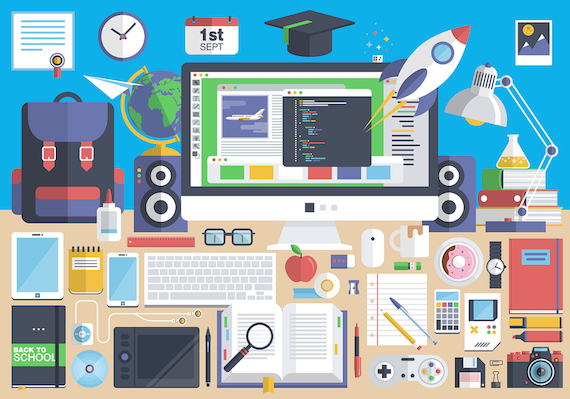The 5 Best Times to Use Technology in Class
At the International Society for Technology in Education (ISTE) conference this summer, there was a great deal of discussion about how this year’s sessions addressed the use of technology. While there are still plenty of “60 apps in 60 minutes” sessions that always draw a crowd (and can help us find great resources), I was glad to see the focus begin to shift in 2015.
We’ve heard for a long time that technology should not be separate from instruction (C’mon kids, let’s all go to the computer lab, and “do” technology!), but should be integrated seamlessly. But for quite some time it seems, we’ve been going at it the wrong way.
How many times have you been asked to take a lesson and find SOME way to integrate technology? This feels a bit backward to me, and it’s time to see technology integration become more organic. I was glad to hear an administrator say while leading a session, “I don’t walk into classrooms to see what technology the kids are using. I walk in to see what they are learning!”
Here’s the key question:
This may seem a bit obvious, but a key question arose during a session, and it helped me a great deal to think about the answer. The question? When is technology most effective? Whoa! Now we’re talking. If technology is just another tool, then we need to think about when it should be used.
You don’t pull a hammer out of your toolbox when you need a screwdriver, so why do we try to “force” technology into lessons where it is not the right tool for the job?
Technology is the right tool when…
1. It helps students visualize concepts. This was particularly true for me when teaching geometry to my middle school students. If you can see and manipulate transformations of shapes, it is much easier to understand them. Looking at animations of scientific processes or reactions is another way to help students truly see and interact with learning, as opposed to relying on still text and images.

3. It makes work easier for students (and often teachers). Does the tool help students keep work organized, or make work flow easier? My English students used web-based NoodleTools for their research papers, which allowed them to keep note cards and sources digitally, and easily link sources to information. All projects were shared with me, which made it easy to provide feedback or comments while they worked. This meant students could keep working during our snow days last year, and never had to worry about losing index cards or copies.


Put technology in its place
As the new school year begins, I encourage you to look at your curriculum with these five opportunities in mind. Then use technology to support your students in ways that take both teaching and learning to a new level. Your “new and improved” classroom will support creativity, collaboration, critical thinking, and communication, and most importantly, will celebrate the gifts of every child.






































I agree with Patti that the use of technology can improve instruction for most students. Having worked in special education for nearly twenty years, it has been great to see teachers using both traditional methods and technology together to reach more students more effectively. Some of the best instruction takes place when a teacher can reach students the way they learn. Straight books or technology only are both limiting. Balance.
Ed,
I think you hit the nail on the head when you talk about balance, and reaching students the way they learn (or enjoy learning!).
Tech has its place, just like any tool we use. It can be a powerful tool, though, when it enhances learning in these ways. Thanks for your thoughts!
Great article! Thanks.
Thank you for sharing this great information with us
While I agree with the outcomes, I think you could make a good argument for the fact that tech should be used ubiquitously and when applied to these 5 elements, all of classtime. When do we, as teachers, not want our students to participate, create, visualize, and collaborate. If we start with the pedagogy of today that emphasizes tech as a tool to expand student opportunities for learning, that allows them to do things that were previously not possible at levels that were previously not achievable. Thanks for sharing your insights…may we all build upon them!
Thanks for your thoughts! I agree that the more ubiquitous tech use becomes, the better. With time, I do see this happening! But at this point, it can feel forced and unnatural as teachers make an effort to meet tech integration goals. Hopefully this IS something to build upon! :)
We’ve come so far and the future is exciting! I love having a SMART Board in my classroom. I use it for everything from calendar to everyday math lessons (with online manipulatives) to virtual field trips! As money is always an issue, I only have 4 ipads and 4 chrome books for my 1st graders but I rotate them in centers as apps are endless! Can’t wait to see what this year brings! I believe technology is finding its place un education and is enhancing it beyond what we ever dreamed!
Corinne,
I agree that this is an exciting time to be an educator! With so many new tools available to us, we are better able to meet the needs of our students, and give them opportunities never possible before. It sounds like you are doing great things in your classroom!
I think kids can be creative and personal with tangible materials, but what I find is that technology often enables them to produce what they call “pro” looking products. Their posters in (for example) Comic Life look production quality, while many of their construction paper ones look more typically middle school (which is also fine on occasion). I find that the kids who have fine motor control issues are especially proud to have their work look awesome.
Elizabeth,
I agree entirely! I had a student last year create a poster in Glogster that was absolutely fabulous. His sense of color, design, and balance enabled him to use those tools to create a poster that was quite impressive. As he does not have strong fine motor skills, this allowed him an opportunity to shine that he would not have had otherwise. I was sure to show it off to everyone – He was so proud! :)